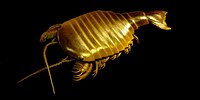Artiopoda
| Artiopoda Temporal range:
| |
|---|---|

| |
| Paradoxides a trilobite | |

| |
| Phytophilaspis, a Xandarellid | |
| Scientific classification | |
| Kingdom: | Animalia |
| Phylum: | Arthropoda |
| (unranked): | †Artiopoda Hou and Bergstrom, 1997 |
| Subgroupings | |
| |
The Artiopoda is a grouping of extinct arthropods that includes trilobites and their close relatives. It was erected by Hou and Bergström in 1997[1] to encompass a wide diversity of arthropods that would traditionally have been assigned to the Trilobitomorpha. Hou and Bergström used the name Lamellipedia as a superclass to replace Trilobitomorpha that was originally erected at the subphylum level, which they considered inappropriate. Trilobites, in part due to their mineralising exoskeletons, are by far the most diverse and long lived members of the clade, with most records of other members, which lack mineralised exoskeletons, being from Cambrian deposits.[2]
Description

According to Stein and Selden (2012) artiopods are recognised by the possession of filiform antennulae, limbs with bilobate exopods, with the proximal lobe being elongate and bearing a lamella, while the distal lobe is paddle-shaped and setiforous (bearing hair-or bristle like structures). The limb endopod has seven podomeres, with first four podomeres bearing inward facing (endite) structures, while podomeres five and six are stenopodous (cylindrical and stout). Common plesiomorphies also include the antellules and at least three sets of post-antellulae limbs being incorporated into the head shield, the postantennular limbs having no or little differentiation into distinct morphologies, and broad paratergal folds which contribute to the dorsoventrally flattened look of artiopods.[3] The limbs of artiopods also bear exites, which are similar to those of the megacheiran Leanchoilia and are likely not homologous to those present in crustaceans.[4]
Taxonomy
Internal taxonomy
Leif Størmer recognised on the basis of limb types that a diverse group of Cambrian arthropods, known largely from the Burgess Shale, were likely to be relatives of the trilobites. Hou and Bergström formalised this grouping into the Lamellipedia, consisting of two clades: the Marrellomorpha and the Artiopoda. The Artiopoda have subsequently been considered to consist of two major clades; one reusing Trilobitomorpha to encompass trilobites, nektaspids, concilitergans and xandarellids, and the other called Vicissicaudata encompassing aglaspidids, xenopods and cheloniellids.[5]
Relationships with other arthropods
The relationship of Artiopoda with the two major clades of modern arthropods, the Chelicerata and the Mandibulata, are unresolved, with some phylogenies recovering Artiopoda as more closely to chelicerates, forming the clade Arachnomorpha, while others recover Artiopoda as more closely related to mandibulates, forming the clade Antennulata.[6]
Gallery
Restoration of the trilobite Triarthrus eatoni
Fossils of Naraoia compacta (Nektaspida)
Life restoration of Sidneyia (Vicissicaudata)
Diagram of Sinoburius (Xandarellida)
Diagram of Emeraldella brutoni (Vicissicaudata)
Phylogeny
After Jiao et al. 2021.[7]
| Artiopoda |
| |||||||||||||||||||||||||||||||||||||||||||||||||||||||||||||||||||||||||||||||||||||||||||||||||||||||||||||||||||||||||||||||||||||||||||||||||||||||||||||||||||||||||||||||||||||||||||||||||||||||||||||||||||||||||||||||||||||||||||||||||||||||||||||||||||||||||||||||||||||||||||||||||||
References
- ^ Hou, X. & Bergström, J. 1997. Arthropods of the Lower Cambrian Chengjiang fauna, southwest China. Fossils and Strata, No. 45. Scandinavian University Press, Oslo, 22 Dec 1997: 116 pp.[1]
- ^ Schmidt, Michel; Hou, Xianguang; Zhai, Dayou; Mai, Huijuan; Belojević, Jelena; Chen, Xiaohan; Melzer, Roland R.; Ortega-Hernández, Javier; Liu, Yu (2021-08-19). "Before trilobite legs: Pygmaclypeatus daziensis reconsidered and the ancestral appendicular organization of Cambrian artiopods". dx.doi.org. Retrieved 2022-07-29.
- ^ Stein, Martin; Selden, Paul A. (June 2012). "A restudy of the Burgess Shale (Cambrian) arthropod Emeraldella brocki and reassessment of its affinities". Journal of Systematic Palaeontology. 10 (2): 361–383. doi:10.1080/14772019.2011.566634. ISSN 1477-2019. S2CID 55018927.
- ^ Liu, Yu; Edgecombe, Gregory D.; Schmidt, Michel; Bond, Andrew D.; Melzer, Roland R.; Zhai, Dayou; Mai, Huijuan; Zhang, Maoyin; Hou, Xianguang (2021-07-30). "Exites in Cambrian arthropods and homology of arthropod limb branches". Nature Communications. 12 (1). doi:10.1038/s41467-021-24918-8. ISSN 2041-1723.
- ^ Ortega-Hernández, Javier; Legg, David A.; Braddy, Simon J. (February 2013). "The phylogeny of aglaspidid arthropods and the internal relationships within Artiopoda". Cladistics. 29 (1): 15–45. doi:10.1111/j.1096-0031.2012.00413.x.
- ^ Aria, Cédric (2022-04-26). "The origin and early evolution of arthropods". Biological Reviews: brv.12864. doi:10.1111/brv.12864. ISSN 1464-7931.
- ^ Jiao, De-Guang; Du, Kun-Sheng; Zhang, Xi-Guang; Yang, Jie; Eggink, Daniel (May 2022). "A new small soft-bodied non-trilobite artiopod from the Cambrian Stage 4 Guanshan Biota". Geological Magazine. 159 (5): 730–734. doi:10.1017/S0016756821001254. ISSN 0016-7568.
Error: "Q19842587" is not a valid Wikidata entity ID.
- Pages with short description
- Articles with short description
- Short description with empty Wikidata description
- Articles with 'species' microformats
- Taxonbars desynced from Wikidata
- Taxonbar pages requiring a Wikidata item
- Taxonbars with invalid from parameters
- Taxonbars without secondary Wikidata taxon IDs
- Artiopoda
- Arthropods
- All stub articles
- Prehistoric arthropod stubs





